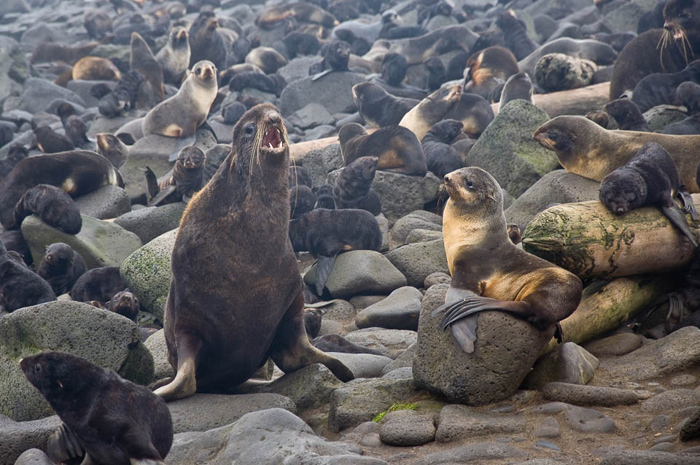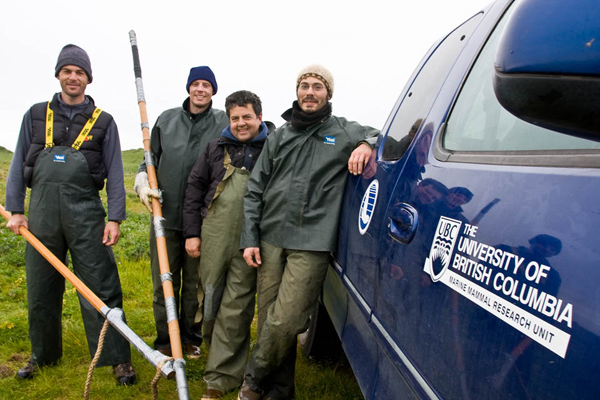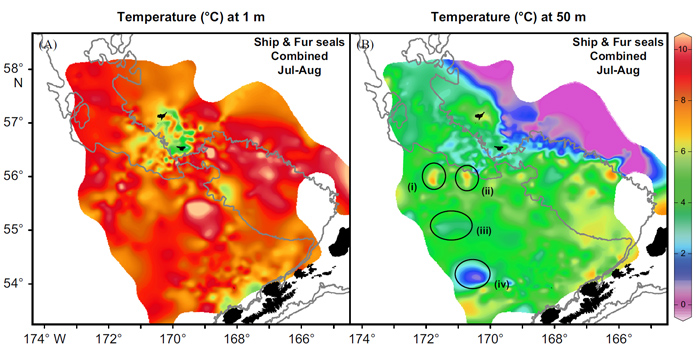
Pups and adult female northern fur seals look on as a bull makes threatening calls.
New research details northern fur seal foraging patterns along ocean fronts
Each summer, the female northern fur seals on Alaska’s remote Pribilof Islands go hunting. Leaving the safety of the land for days at a time, they must find enough food to give them the energy to continue nursing their newborn pups. If they are lucky, they’ll find a large patch of prey in one place. If not, they’ll graze along the way until their instincts call them home.
What causes this pattern of behavior? Where do northern fur seals go when they are at sea, and how do they know where to find food?
These questions are at the core of two new studies led by Chad Nordstrom (UBC Marine Mammal Research Unit) and published in Deep-Sea Research II.
Working with 87 lactating female fur seals fitted with high-tech tracking tags, Nordstrom analyzed thousands of dive profiles logged over dozens of foraging trips, some of which lasted over one week. The data from the tags gave him detailed insights on how far and how deep the seals travel, and where they stop to eat.
Animation showing two northern fur seals originating from St. Paul Island foraging along a submesoscale surface front over the central shelf-break and basin of the eastern Bering Sea. Individual fur seals are represented by colored lines. Fronts are depicted as dark bands and are 4-day snapshots; and time of day is shown at the bottom in GMT. |
“I wanted to know why the fur seals were foraging in those locations,” Nordstrom says. “In order to answer that question I needed to collect more advanced oceanographic data, and I was lucky enough to collaborate with a group of researchers who were doing just that.”

Fur seal researchers (from left to right) John Gibbens, Chad Nordstrom, Andrew Trites, and Al Baylis
Fine-scale Ocean Fronts
Nordstrom joined the Patch Dynamics Team of the Bering Sea Integrated Ecosystem Research Program, a team of oceanographers and biologists who were mapping the intricate interplay between the physical ocean and the life within it. The collaboration gave Nordstrom a chance to compare the oceanographic data from his tags—produced by foraging fur seals—with measurements taken aboard a ship.
“It’s a little like tracing the outline of a picture and then coloring it in,” Nordstrom explains. “When environmental variables like ocean temperatures are collected by a ship or a satellite, it paints a broad picture that misses the

A daily diary tag carried by northern fur seals to record water temperature, depth, light levels, acceleration, and directional movement as frequently as 16 times per second.
nitty-gritty details. By tracking tagged animals as they move around and collect data about their environment, we could fill in the information gaps by looking at the data in finer detail than anyone had before.”
Some of Nordstrom’s tagged fur seals would linger in particular spots and then head home directly. Others would run a predictable circuit of the ocean. But the patterns were inconsistent, and Nordstrom’s data couldn’t explain this behavior—until he began to overlay fine-scale maps of ocean currents generated by an oceanographer.
“That’s when everything started to make sense,” Nordstrom says. “It turns out the seals were eating along narrow ribbons of current, which acted like an invisible fence to concentrate prey in one place.”
“These small-scale anomalies—ocean fronts—are like currents within a current,” Nordstrom explains, “which channel zooplankton into corridors. A concentration of zooplankton at the face of an ocean front attracts fish and squid, which in turn attract larger predators like fur seals.”

Water temperatures (ranging from 0-10C) of the eastern Bering Sea at 1m (left panel) and 50m (right panel). Data were collected from ships and northern fur seals in 2009. Anomalously cold and warm eddies are circled in the right panel.
Location Matters
Nordstrom’s studies compared two cohorts of fur seals—one on St. Paul Island and one on Bogoslof Island. He was surprised to find that fur seals from St. Paul Island ventured three times farther and stayed at sea twice as long as fur seals from Bogoslof Island. This suggests that prey may be less concentrated near St. Paul Island, requiring lengthier foraging trips.The take-home message, Nordstrom says, is that location matters for northern fur seals.
“Female northern fur seals are tied to one rookery when they are raising their pups,” Nordstrom says. “So the availability of high-quality prey around them has a huge impact on their choices when foraging. The availability and proximity of prey to nursing females, which is largely determined by the location of ocean fronts, could determine the fate of an entire population.”
 PUBLICATIONS
PUBLICATIONS
[webref_bio title=”Foraging habitats of lactating northern fur seals are structured by thermocline depths and submesoscale fronts in the eastern Bering Sea”]
[webref_bio title=”Northern fur seals augment ship-derived ocean temperatures with higher temporal and spatial resolution data in the eastern Bering Sea”]
